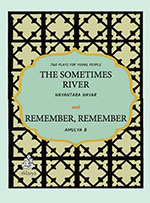This book is the outcome of a residency programme for playwrights in 2021 through a collaboration of ThinkArts, Parag and Eklavya. The unintended backdrop of this residency was the Covid 19 pandemic, so it is not surprising that the subject of these two plays has a sense of urgency to reimagine how our relationship to nature could be reordered.
The two plays fall within a post-apocalyptic genre. In quite different ways the characters of both plots are survivors of cataclysmic events that have all but wiped out the chances of a regeneration of Planet Earth. Neither of the plays are didactic or overtly moralistic, but each story invites the audience to grapple with emotions and ideas that are inescapable in our present troubled and, increasingly, fragile world.
In The Sometimes River the few human survivors have retreated under the earth to escape from the blistering heat of the arid land. They live in ‘the shadowy remains of a dead world’ with only a fading memory of rainclouds, flourishing vegetation and a thriving animal world.
The drama opens at a time of crisis as life in the caves is ‘sliding into chaos’. There is a vacuum of leadership as the dwindling community faces problems of scarcity and theft; communication has broken down and only rumours, secrets, broken promises and lies are rife. Tensions rise as sickness and death increase and chances of survival for the whole community seem to diminish.
There are Runners who forage for food under cover of darkness above ground and Diggers who search for underground sources of water but rivalries between the two are on the increase as the situation deteriorates.
Mariamma, the Keeper of Stories, can offer little solace. She describes her role as ‘Rewriting stories that are crumbling’. But others accuse her of not seeing things as they really are and mock her art of storytelling. For many, in that dire situation, stories seem to have lost their power except to frighten the foolish from exploring any other way out of their plight.
It is Mariamma’s grandson Ko and her precocious young apprentice Varun who urge the narrative forward and try to seek some other way than denial and paralysis. Both Ko and Varun are ready to risk their lives and liberty to find answers to the questions that might bring relief to the whole community. This prompts two of the senior members of the community to act and not evade the responsibility they hold.
Haunting stories and dreams are skillfully woven into the text. Broken relationships begin to be re-forged, and a new story starts to emerge. The search for ‘The Sometimes River’ reveals unexpected disaster and a realization that it will take a different kind of leadership to affirm that the human community is still part of a living planet.
The second, shorter play in the book is Remember, Remember by Amulya B. It is a poignant play that centres round the aftermath of a catastrophic flood following the collapse of a dam. The two survivors exist in a Museum of Lost Objects in the hope that one day the salvaged objects they preserve will once again be part of a dynamic world of relationships and interdependence. The dusty museum begins to become a place of meetings and creation. The drama moves back and forth in time and, most significantly, towards a future as the characters lament not only what has been lost but remember what gave their lives meaning.
Loss and longing are two central themes of the play. The struggle to recreate the butterfly and not just construct ‘a mini metal drone’ means understanding processes that cause destruction and those that give life.
Plays are not an easy genre for readers to enter but, as written in the introduction, ‘a play compels readers to become active participants instead of passive receptors.’ In one way reading a play is rather like studying a two-dimensional architectural plan as opposed to experiencing it as a three-dimensional lived space. Both these plays are a challenge for the reader to visualize the story in action, sound and image but also give freedom to interpret the words.
The plays are licensed under Creative Commons and the chance to perform these plays is open to all. These two dramas are specifically written for young people and the act of transposing the printed word to the theatre space would demand a deep engagement with the contemporary issues they confront.
The two plays engage with the reality of a threatened planet, but both offer some possibility of agency in reading the signs, protesting about destructive development and realizing some hope of regeneration and new beginnings.
November 2023, volume 47, No 11

